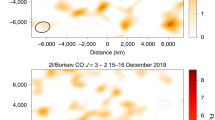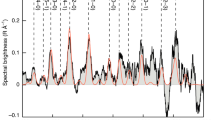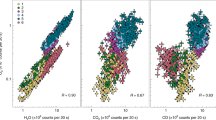Abstract
Cometary comae are generally depleted in nitrogen. The main carriers for volatile nitrogen in comets are NH3 and HCN. It is known that ammonia readily combines with many acids, such as HCN, HNCO and HCOOH, encountered in the interstellar medium as well as in cometary ice to form ammonium salts (NH4+X−) at low temperatures. Ammonium salts, which can have a substantial role in prebiotic chemistry, are hard to detect in space as they are unstable in the gas phase and their infrared signature is often hidden by thermal radiation or by, for example, OH in minerals. Here we report the presence of all possible sublimation products of five different ammonium salts in the comet 67P/Churyumov–Gerasimenko measured by the ROSINA instrument onboard Rosetta. The relatively high sublimation temperatures of the salts leads to an apparent lack of volatile nitrogen in the coma. This then also explains the observed trend of higher NH3/H2O ratios with decreasing perihelion distances in comets.
This is a preview of subscription content, access via your institution
Access options
Access Nature and 54 other Nature Portfolio journals
Get Nature+, our best-value online-access subscription
$29.99 / 30 days
cancel any time
Subscribe to this journal
Receive 12 digital issues and online access to articles
$119.00 per year
only $9.92 per issue
Buy this article
- Purchase on Springer Link
- Instant access to full article PDF
Prices may be subject to local taxes which are calculated during checkout





Similar content being viewed by others
Data availability
The datasets analysed during the current study together with a user manual for data analysis are available in the ESA-PSA archive (https://www.cosmos.esa.int/web/psa/rosetta) or the NASA PDS archive (https://pdssbn.astro.umd.edu/data_sb/missions/rosetta/index.shtml).
References
Dello Russo, N. D., Kawakita, H., Vervack, R. J. Jr & Weaver, H. A. Emerging trends and a comet taxonomy based on the volatile chemistry measured in thirty comets with high-resolution infrared spectroscopy between 1997 and 2013. Icarus 278, 301–332 (2016).
Bockelée-Morvan, D. & Biver, N. The composition of cometary ices. Philos. Trans. R. Soc. A 375, 20160252 (2017).
Geiss, J. in Cosmic Chemistry (ed. Klare, G.) 1–27 (Springer, 1988).
Rubin, M. et al. Krypton isotopes and noble gas abundances in the coma of comet 67P/Churyumov–Gerasimenko. Sci. Adv. 4, eaar6297 (2018).
Cochran, A. L. & McKay, A. J. Erratum: ‘Strong CO+ and emission in comet C/2016 R2 (Pan-STARRS)’(2018, ApJL, 854, L10). Astrophys. J. Lett. 856, L20 (2018).
Lodders, K. in Principles and Perspectives in Cosmochemistry: Lecture Notes of the Kodai School on ‘Synthesis of Elements in Stars’ held at Kodaikanal Observatory, India, April 29–May 13, 2008 (eds Goswami, A. & Reddy, E. B.) 379–419 (Springer, 2010).
Jessberger, E. K., Christoforidis, A. & Kissel, J. Aspects of the major element composition of Halley’s dust. Nature 332, 691–695 (1988).
Fray, N. et al. Nitrogen-to-carbon atomic ratio measured by COSIMA in the particles of comet 67P/Churyumov–Gerasimenko. Mon. Not. R. Astron. Soc. 469, S506–S516 (2017).
DiSanti, M. A. et al. En route to destruction: the evolution in composition of ices in comet D/2012 S1 (ISON) between 1.2 and 0.34 AU from the sun as revealed at infrared wavelengths. Astrophys. J. 820, 34 (2016).
Mumma, M. J. & Charnley, S. B. The chemical composition of comets—emerging taxonomies and natal heritage. Annu. Rev. Astron. Astrophys. 49, 471–524 (2011).
Whittet, D. C. B. et al. An ISO view of interstellar ices—first results. Astron. Astrophys. 315, L357–L360 (1996).
van Broekhuizen, F. A., Pontoppidan, K. M., Fraser, H. J. & Van Dishoeck, E. F. A 3–5 mm VLT spectroscopic survey of embedded young low mass stars II: solid OCN−. Astron. Astrophys. 441, 249–260 (2005).
De Sanctis, M. C. et al. Bright carbonate deposits as evidence of aqueous alteration on (1) Ceres. Nature 536, 54–57 (2016).
Quirico, E. et al. Refractory and semi-volatile organics at the surface of comet 67P/Churyumov–Gerasimenko: insights from the VIRTIS/Rosetta imaging spectrometer. Icarus 272, 32–47 (2016).
Capaccioni, F. A. et al. The organic-rich surface of comet 67P/Churyumov–Gerasimenko as seen by VIRTIS/Rosetta. Science 347, aaa0628 (2015).
Bergner, J. B., Öberg, K. I., Rajappan, M. & Fayolle, E. C. Kinetics and mechanisms of the acid-base reaction between NH3 and HCOOH in interstellar ice analogs. Astrophys. J. 829, 85 (2016).
Balsiger, H. et al. Rosina–Rosetta orbiter spectrometer for ion and neutral analysis. Space Sci. Rev. 128, 745–801 (2007).
Rubin, M. et al. Elemental and molecular abundances in comet 67P/Churyumov–Gerasimenko. Mon. Not. R. Astron. Soc. 489, 594–607 (2019).
Della Corte, V. et al. GIADA—Grain Impact Analyzer and Dust Accumulator—onboard Rosetta spacecraft: extended calibrations. Acta Astronaut. 126, 205–214 (2016).
Gasc, S. et al. Change of outgassing pattern of 67P/Churyumov–Gerasimenko during the March 2016 equinox as seen by ROSINA. Mon. Not. R. Astron. Soc. 469, S108–S117 (2017).
Hänni, N. et al. Ammonium salts as a source of small organic molecules observed with high-resolution electron-impact ionization mass spectrometry. Phys. Chem. A 123, 5805–5814 (2019).
Meier, R., Eberhardt, P., Krankowsky, D. & Hodges, R. R. Ammonia in comet P/Halley. Astron. Astrophys. 287, 268–278 (1994).
De Keyser, J. et al. Evidence for distributed gas sources of hydrogen halides in the coma of comet 67P/Churyumov–Gerasimenko. Mon. Not. R. Astron. Soc. 469, S695–S711 (2017).
Cottin, H. & Fray, N. Distributed sources in comets. Space Sci. Rev. 138, 179–197 (2008).
Cordiner, M. A. et al. Mapping the release of volatiles in the inner comae of comets C/2012 F6 (Lemmon) and C/2012 S1 (ISON) using the Atacama Large Millimeter/Submillimeter Array. Astrophys. J. Lett. 792, L2 (2014).
Lis, D. C. et al. Hydrogen isocyanide in comet 73P/Schwassmann–Wachmann (fragment B). Astrophys. J. 675, 931–936 (2008).
Cordiner, M. A. et al. ALMA mapping of rapid gas and dust variations in comet C/2012 S1 (ISON): new insights into the origin of cometary HNC. Astrophys. J. 838, 147 (2017).
Altwegg, K. et al. Prebiotic chemicals—amino acid and phosphorus—in the coma of comet 67P/Churyumov–Gerasimenko. Sci. Adv. 2, e1600285 (2016).
Pascal, R., Boiteau, L. & Commeyras, A. From the prebiotic synthesis of α-amino acids towards a primitive translation apparatus for the synthesis of peptides. Top. Curr. Chem. 259, 69–122 (2005).
Huber, C. & Wächtershäuser, G. Primordial reductive amination revisited. Tetrahedron Lett. 44, 1695–1697 (2003).
Barge, L. M., Flores, E., Baum, M. M., VanderVelde, D. G. & Russell, M. J. Redox and pH gradients drive amino acid synthesis in iron oxyhydroxide mineral systems. Proc. Natl Acad. Sci. USA 116, 4828–4833 (2019).
Oro, J. Synthesis of adenine from ammonium cyanade. Biochem. Biophys. Res. Commun. 2, 407–412 (1960).
Islam, S., Bučar, D.-K. & Powner, M. W. Prebiotic selection and assembly of proteinogenic amino acids and natural nucleotides from complex mixtures. Nat. Chem. 9, 584–589 (2017).
Islam, S. & Powner, M. W. Prebiotic systems chemistry: complexity overcoming clutter. Chem 2, 470–501 (2017).
Biver, N. et al. Ethyl alcohol and sugar in comet C/2014 Q2 (Lovejoy). Sci. Adv. 1, e1500863 (2015).
Läuter, M., Kramer, T., Rubin, M. & Altwegg, K. Surface localization of gas sources on comet 67P/Churyumov–Gerasimenko based on DFMS/COPS data. Mon. Not. R. Astron. Soc. 483, 852–861 (2018).
Le Roy et al. Inventory of the volatiles on comet 67P/Churyumov–Gerasimenko from Rosetta/ROSINA. Astron. Astrophys. 583, A1 (2015).
Calmonte, U. et al. Sulphur-bearing species in the coma of comet 67P/Churyumov–Gerasimenko. Mon. Not. R. Astron. Soc. 462, S253–S27 (2016).
Steins, S. E. in NIST Chemistry WebBook, NIST Standard Reference Database Number 69 (eds Linstrom, P. J. & Mallard, W. G.) https://doi.org/10.18434/T4D303 (National Institute of Standards and Technology, 2018).
Martinez, R., Bordalo, V., da Silveira, E. F. & Boechat-Roberty, H. M. Production of NH4 + and OCN− ions by the interaction of heavy-ion cosmic rays with CO–NH3 interstellar ice. Mon. Not. R. Astron. Soc. 444, 3317–3327 (2014).
Dunitz, J. D. et al. New light on an old story: the solid-state transformation of ammonium cyanate into urea. J. Am. Chem. Soc. 120, 13274–13275 (1998).
Hand, C. W. & Bogan, D. J. Mass spectrum of isocyanic acid. J. Phys. Chem. 75, 1532–1536 (1971).
Theulé, P. et al. Hydrogenation of solid hydrogen cyanide HCN and methanimine CH2NH at low temperature. Astron. Astrophys. 534, A64 (2011).
Kissel, J. et al. COSIMA—high resolution time-of-flight secondary ion mass spectrometer for the analysis of cometary dust particles onboard Rosetta. Space Sci. Rev. 128, 823–867 (2007).
Fray, N. et al. High-molecular-weight organic matter in the particles of comet 67P/Churyumov–Gerasimenko. Nature 538, 72–74 (2016).
Acknowledgements
ROSINA would not have produced such outstanding results without the work of the many engineers, technicians and scientists involved in the mission, in the Rosetta spacecraft team and in the ROSINA instrument team over the past 20 years, whose contributions are gratefully acknowledged. Rosetta is an ESA mission with contributions from its member states and NASA. We acknowledge herewith the work of the whole ESA Rosetta team. Work at the University of Bern was funded by the State of Bern, the Swiss National Science Foundation (SNSF, 200021_165869 and 200020_182418), the Swiss State Secretariat for Education, Research and Innovation (SERI) under contract number 16.0008- 2, the European Space Agency’s PRODEX programme. S.W. acknowledges the financial support of the SNSF Eccellenza Professorial Fellowship PCEFP2_181150. J.D.K. acknowledges support by the Belgian Science Policy Office via PRODEX/ROSINA PEA 90020. S.A.F. acknowledges JPL contract 1496541. Work at UoM was supported by contracts JPL 1266313 and JPL 1266314 from the US Rosetta Project. H.C. is grateful to M. Powner for discussions about prebiotic chemistry during the preparation of the manuscript.
Author information
Authors and Affiliations
Contributions
K.A. was principal investigator of the ROSINA instrument, analysed the data and wrote part of the paper. H.B., J.-J.B., M.C., J.D.K., B.F., S.A.F. and T.I.G. contributed hardware to the instrument. M.R., F.D., M.S., I.S. and T.S. operated and calibrated the instrument. N.H. did laboratory experiments on salts and added to the chemistry. C.B., H.C. and S.W. contributed the part of the paper about the interstellar and astrobiological consequences. All authors read and commented on the paper.
Corresponding author
Ethics declarations
Competing interests
The authors declare no competing interests.
Additional information
Publisher’s note Springer Nature remains neutral with regard to jurisdictional claims in published maps and institutional affiliations.
Extended data
Extended Data Fig. 1 Sample DFMS spectra for m/z 60.
ROSINA-DFMS mass spectrum, Sept. 5, 2016, 18:34 h. Error bars are 1-σ statistical errors. Blue/Grey curves are the two Gaussians, which describe the peaks, sharing the width across the spectrum.
Extended Data Fig. 2 Total densities during the end of mission ellipses.
Total density from Aug. 26 to Sept. 5, 2016 (upper panel) and a zoom for Sept. 5, 15 h – 22 h UTC, measured by ROSINA-COPS. Also displayed are sub-spacecraft latitude in red and the filament current of DFMS for Sept. 5 in blue.
Extended Data Fig. 3 Ammonia density with time on 5./6. Sept. 2016.
Ammonia density as a function of time on 5./6. September 2016.
Extended Data Fig. 4 Amines and their fragments.
Comparison of methylamine and ethylamine fragments from electron impact ionization according to NIST and from measurements in space (Sept. 5, 2016, 20:19 h).
Supplementary information
Supplementary Information
Supplementary Tables 1–3.
Rights and permissions
About this article
Cite this article
Altwegg, K., Balsiger, H., Hänni, N. et al. Evidence of ammonium salts in comet 67P as explanation for the nitrogen depletion in cometary comae. Nat Astron 4, 533–540 (2020). https://doi.org/10.1038/s41550-019-0991-9
Received:
Accepted:
Published:
Issue Date:
DOI: https://doi.org/10.1038/s41550-019-0991-9
This article is cited by
-
Nitrogen K-edge X-ray adsorption near-edge structure spectroscopy of chemically adsorbed ammonia gas on clay minerals and the 15N/14N-nitrogen isotopic fractionation
Analytical Sciences (2024)
-
The Comet Interceptor Mission
Space Science Reviews (2024)
-
Distributions of CHN compounds in meteorites record organic syntheses in the early solar system
Scientific Reports (2023)
-
Investigating Europa’s Habitability with the Europa Clipper
Space Science Reviews (2023)
-
Identification and characterization of a new ensemble of cometary organic molecules
Nature Communications (2022)



